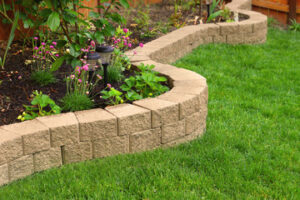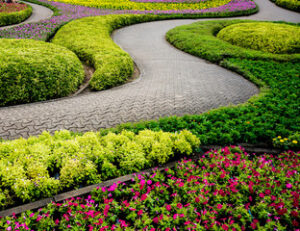A well-designed landscape enhances curb appeal and increases property value. It also creates a peaceful place to relax and boosts health by lowering blood pressure.

Landscaping also provides environmental benefits such as removing carbon dioxide, producing oxygen, capturing dust and smoke, and preventing flooding. Starting with a plan is essential to achieving the landscape you desire. Reach out Prime Cut Lawn And Landscaping for comprehensive assistance.
Color is a powerful element that elevates landscaping from “pretty” to truly impactful. It can evoke emotions, draw attention to specific areas, make spaces feel bigger or smaller, and establish harmony, among other things. It is also a crucial aspect of a landscape’s overall beauty and can make the difference between an ordinary garden and one that will make your neighbors jealous.
Colors may be grouped into warm and cool categories, with warmer colors such as reds, yellows, and oranges having a tendency to stimulate the senses and energize, making them ideal for active spaces where you want to encourage interaction. Cool colors, on the other hand, are more soothing and calming and can offer a sense of peace in spaces that are meant for relaxation.
Neutral colors, such as greys and whites, can help create a balance in a landscape by serving as a backdrop that allows other colors to stand out without being overpowering. Additionally, they can add a sense of sophistication and help the surrounding architecture and structures to take center stage.
The intensity of a color also plays an important role in the landscape, with brighter hues being more noticeable and attention-grabbing than their darker counterparts. This makes them great for drawing the eye to specific elements, but be careful not to overdo it as they can be overwhelming. For this reason, it is often best to choose a neutral-colored background to serve as the focal point of the landscape and let other colors provide contrast.
Lastly, the relationship of colors to one another is also important. Colours that are adjacent or opposite on the color wheel tend to be complementary and enhance each other, while colors that are similar tend to blend in more softly. Considering this, it’s often useful to choose a limited number of complimentary colors to ensure that your landscape will look good throughout the year as other plants come in and out of bloom.
With the right knowledge and planning, you can use color to evoke emotion, create focal points, enhance space, establish harmony, and utilize seasonal color transitions. By taking these factors into consideration, you can create a beautiful and functional landscape for your home that will impress your neighbors and provide you with an outdoor sanctuary to enjoy.
Form
In a landscape, form refers to the three-dimensional qualities of plants, hardscape and structures. It also includes the way these elements are arranged to create unity within the design. This element is typically a result of a combination of factors, including the purpose of the landscape, personal preference and how a property sits in relation to its neighbors.
Landscape forms are often defined by a hardscape structure, such as the edges of a walkway, path or fence, or by the shape of a tree or shrub. Form is important because it impacts a landscape’s flow and visual weight. For example, a straight line can have a formal feel, while a curved line is more natural.
Form can also impact a garden’s ambiance. Rectilinear shapes are often seen in more formal gardens, while rounded or irregular shapes can add a casual look. Using different forms throughout a landscape creates texture and contrast and is key to a well-balanced design.
Texture is another important characteristic of a landscape, and it can be created by the shape of an object, its color or its texture. A rough surface may be more dramatic than a smooth surface, and the presence or absence of light can also affect how an object appears. The combination of contrasting textures and the use of empty spaces help to create balance and harmony in a design.
Unity is the underlying theme of a successful landscaping project. It is achieved through the blending of similar characteristics to give the design continuity and create consistency. This can be achieved through a variety of means, including the repetition of plant shapes and styles and the use of a theme or design style.
Landscape colors vary by season and are influenced by the amount of sunlight a garden receives. This can cause the colors to appear more vibrant and intense during the summer, while a softer and more muted appearance is typical in the winter. A landscape’s color should be used to emphasize other, more enduring aspects of the design, such as form and texture.
Space
A well-designed landscape takes advantage of space in a way that makes the entire property feel connected and functional. This can be accomplished through the use of visual elements, such as scale and proportion, as well as the arrangement of plants.
The use of color is another important part of creating a sense of space in the yard. Warm colors, such as reds and yellows, draw the eye and make objects seem closer together. Cooler colors, such as blues and greens, create a more expansive feeling. By using these color concepts, a landscaper can make the yard feel larger or smaller depending on the desired effect.
Another important aspect of space is line, which can be created by using structure such as fences and walls or by defining different areas with the use of walkways, paths and garden beds. It’s important that the lines of sight from the house into the garden and vice versa are taken into consideration when designing the layout. Garden beds that are shaped into curves instead of straight edges feel more spacious.
People are drawn to outdoor spaces that are surrounded by natural beauty, and landscaping professionals play an important role in creating these spaces. People are often able to relax and de-stress in these spaces, and research has shown that spending time in nature can help reduce anxiety levels. Furthermore, a well-designed landscape can encourage physical activity by providing opportunities for recreation and exercise.
People may not be aware of how much of a positive impact that green spaces have on the environment. However, these green spaces are vitally important to the survival of our planet and the lives of its inhabitants. The work that landscapers do helps preserve these spaces, and with increasing awareness of environmental issues, their importance is sure to grow. If you’re interested in learning more about how the work of landscapers can improve your quality of life, contact a professional today. They can provide a detailed consultation and explain the process of turning an empty backyard into your dream yard. They can also recommend different materials and plants that will suit your specific needs and taste.
Maintenance
A well-kept landscape is not only pleasing to the eye, but it also adds value to your property. It increases curb appeal, which attracts potential buyers or tenants and makes your home or business more appealing to clients and guests. In addition, studies have shown that access to green spaces has a positive impact on mental and physical health, reducing stress, improving focus, and promoting relaxation.
Maintenance includes both hardscape and softscape services, such as mowing, weeding, aeration, watering, pruning, mulching, fertilization, and tree and shrub care. Landscape maintenance is more than just a routine service; it requires careful attention to the plants and features in order to ensure their health, longevity, and beauty. It also involves regular monitoring of the landscape for changes and the identification of potential problems, which can then be addressed before they become more severe.
Keeping your landscape properly maintained not only improves the appearance of your property, but it can also reduce operating costs. Water-efficient irrigation systems and seasonal landscaping practices are just two ways that you can cut back on your utility bills. Regular maintenance also helps prevent costly repairs by catching issues before they escalate.
In addition, regular landscape maintenance can enhance safety on your property. Overgrown trees, cluttered walkways, and debris can create hazardous conditions that may increase the risk of accidents and injuries. Trimming branches, removing invasive species, and clearing away debris can all help prevent these hazards.
Maintaining a landscape is a time-consuming and often labor-intensive process. Unless you have the experience and the tools, it’s typically more cost-effective to hire professional landscapers to handle your maintenance needs. Besides the physical labor involved in raking, blowing leaves, and mowing, landscapers can provide services like soil testing and consultation, plant selection and care, tree trimming and disease management, pond and waterfall construction, retaining wall installation, and more.
In addition to performing a variety of landscape maintenance services, landscapers can also offer customer service, including communicating with clients and property managers, providing recommendations for improvements, and ensuring customer satisfaction. They can also help you develop a comprehensive landscape plan that meets your needs and budget.
